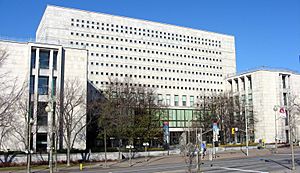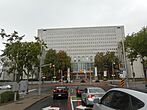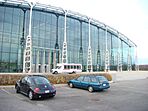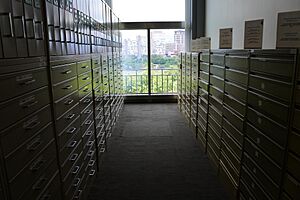Library and Archives Canada facts for kids
Quick facts for kids Library and Archives Canada |
|
|---|---|
 |
|
| Library and Archives Canada building in Ottawa | |
| Type | National library and national archives |
| Established | May 21, 2004 |
| Location | 395 Wellington Street, Ottawa, Ontario, Canada |
| Collection | |
| Items collected | Aboriginal magazines; albums and scrapbooks; architectural drawings; art; artifacts; Canadian children's literature; Canadian comic books; Canadian newspapers; Canadian periodicals; electronic publications; electronic records; English-language pulp literature; ethnic community newsletters; ephemera; fiction and non-fiction; films; globes; government publications; government records; government websites; Hebraica and Judaica; Indian residential school records; journals and diaries; livres d’artistes; manuscripts; maps; microfilms; photographs; poetry; portraits; rare books; sheet music; sketchbooks; sound recordings; stamps; textual archives; theses and dissertations; trade catalogues; videos |
| Size | 22 million books and publications (periodicals, newspapers, microfilms, literary texts, and government publications); 250 km of government and private textual records; 3 million architectural drawings, maps, and plans; 30 million photos; 350,000 hours of film; 425,000 works of art (including paintings, drawings, watercolours, posters, prints, medals, and caricatures); 547,000 musical items; over 1 billion MB of digital content |
| Criteria for collection | Canadiana, documents published in Canada and materials published elsewhere of interest to Canada; records documenting the functions and activities of the Government of Canada; records of heritage value that document the historical development and diversity of Canadian society |
| Legal deposit | Yes |
| Other information | |
| Budget | CDN$98,346,695 (2013–14) |
| Director | Leslie Weir |
| Staff | 853 FTE (2021–22) |
Library and Archives Canada (LAC) is like Canada's memory bank. It's a special place that collects, keeps safe, and shares important documents and items from Canada's past and present. It acts as both the country's main library and its main archives.
LAC is one of the largest libraries in the world. It works for the Canadian government and reports to the Parliament of Canada through the Minister of Canadian Heritage.
LAC started a long time ago. Its roots go back to the Dominion Archives, which began in 1872. Later, the National Library of Canada was created in 1953. In 2004, these two important organizations joined together to form Library and Archives Canada.
Contents
History of Canada's Memory Keepers
Early Beginnings
The Dominion Archives started in 1872. Its job was to find and copy documents about Canadian history. In 1912, it became its own organization called the Public Archives of Canada. It then started managing government documents of all kinds. In 1987, it was renamed the National Archives of Canada.
The National Library of Canada was created in 1953. This happened thanks to the hard work of people like Freda Farrell Waldon, who was the first president of the Canadian Library Association.
Joining Forces in the 21st Century
In 2004, the National Archives of Canada and the National Library of Canada combined. This created Library and Archives Canada (LAC). This merger was suggested by Roch Carrier, who was the National Librarian, and Ian E. Wilson, who was the National Archivist.
The new organization was officially formed on May 21, 2004. Ian Wilson became the first Librarian and Archivist of Canada in July of that year.
Modernizing for the Future
After LAC was formed, it looked at how it could improve. It wanted to become a new kind of knowledge place. It also aimed to be a truly national organization that works with others to protect Canada's history.
LAC decided to focus more on digital items. This meant moving from mostly collecting physical things to also collecting and keeping digital information safe. They wanted to make sure that Canada's history could be found and used easily in the digital world.
Changes and Challenges
Over the years, LAC has faced some challenges. There have been changes to how it operates and how much money it receives. These changes sometimes affected the services it could offer.
Many groups and people have shared their thoughts about these changes. They wanted to make sure that LAC could continue its important work of preserving Canada's history. For example, the Canadian Association of University Teachers started a campaign to support LAC.
In 2013, after the leader of LAC changed, the Heritage Minister said that making records digital would be a top goal. He also wanted to look again at some programs that had been stopped.
Working with the Truth and Reconciliation Commission
Library and Archives Canada played a role in the Truth and Reconciliation Commission of Canada. This commission looked into the history and impacts of residential schools in Canada.
LAC was asked to provide records for the commission. It worked to make these records available, including digitizing them so they could be easily searched.
The commission's final report asked LAC to do more. It asked LAC to make sure its records about residential schools are easy for everyone to access. It also asked LAC to create more educational materials about residential schools.
LAC has started to address these requests. It is hiring Indigenous archivists and working with Indigenous communities. It is also supporting efforts to digitize more records.
LAC Buildings and Online Access
The main building for Library and Archives Canada is at 395 Wellington Street in downtown Ottawa. This is where people can visit to see parts of the collection. This building opened in 1967.
LAC also has other important buildings. There are offices in Gatineau, Quebec. There are also special places across Canada to store and protect government records.
One key building is the Preservation Centre in Gatineau. It was built to keep Canada's valuable collections safe for a very long time. It has 48 special rooms with controlled climates. These rooms help protect old documents, films, and other items. It opened in 1997.
There is also a special facility in Shirleys Bay for old nitrate films. These films are very old and need exact temperatures to be preserved. This building helps keep these important early Canadian films safe. It opened in 2011.
LAC also has a new high-tech storage facility in Gatineau. This facility helps protect Canada's published heritage, like old newspapers and records from Second World War veterans.
You can also explore LAC's collection online! Their website has lots of information. They also share updates and content on their blog, podcasts, Twitter, Facebook, Flickr, and YouTube.
What LAC Collects
Library and Archives Canada holds a huge collection of items that tell Canada's story. It's like a giant treasure chest of Canadian history!
Here are some of the things you can find in their collection:
- Over 250 kilometers of government and private written records.
- 22 million books and other publications.
- 24 million photos, including prints, negatives, and digital pictures.
- Over 3 million architectural drawings, plans, and maps.
- More than 90,000 films, from short movies to documentaries.
- Over 550,000 hours of audio and video recordings.
- More than 425,000 works of art, like paintings, drawings, and posters.
- About 550,000 musical items, including the largest collection of Canadian sheet music in the world.
- The Canadian Postal Archives, which has items related to Canada's postal history.
- National newspapers from all over Canada, including daily papers and Indigenous magazines.
Cool Items in the Collection
Some items in the collection are extra special:
- The original Proclamation of Canada's Constitution Act, 1982. It even has raindrop marks from when Queen Elizabeth II signed it in 1982!
- A copy of the Constitution Act, 1867, with notes from Canada's first Prime Minister, Sir John A. Macdonald.
- De antiquitate Judaica: De bello Judaico—the oldest book in the collection. It was printed in 1470!
- The actual chair used by the famous pianist Glenn Gould when he played and recorded music.
Digital Collection
LAC also has a massive amount of digital content. This includes many books, Canadian theses, and census records. While a lot of the collection is still in physical form, LAC is working to digitize more items. As of 2013, about 1% of the collection had been digitized. This included about 25 million of the most popular and fragile items.
How LAC Works
LAC's main job is to:
- Keep Canada's history safe for everyone, now and in the future.
- Be a place of knowledge that helps Canada grow as a free and fair society.
- Help different groups in Canada work together to collect and share knowledge.
- Be the official memory of the Canadian government.
Who Leads LAC?
The person in charge of Library and Archives Canada is called the Librarian and Archivist of Canada. This person has a very important role, similar to a deputy minister in the government.
As of August 2019, Leslie Weir became the Librarian and Archivist of Canada. She is the first woman to hold this important position. Her term has been extended to help with new building projects.
Before 2004, the head of the archives was called the Dominion Archivist (from 1872 to 1987) and then the National Archivist (from 1987 to 2004).
| Name | Period in office | Note |
|---|---|---|
| Librarian and Archivist of Canada | ||
| Leslie Weir | 2019–incumbent | first woman to hold this role |
| Guy Berthiaume | 2014–19 | |
| Daniel J. Caron | 2009–13 | |
| Ian E. Wilson | 2004–09 | Wilson was the National Archivist before LAC was created. He then became the first Librarian and Archivist of Canada. |
| National Librarian of Canada | ||
| Roch Carrier | 1999–2004 | |
| Marianne Scott | 1984–99 | |
| Guy Sylvestre | 1968–83 | |
| William Kaye Lamb | 1953–68 | |
| National/Dominion Archivist | ||
| Ian E. Wilson | 1999–2004 | National Archivist until the role merged with the National Librarian. |
| Jean-Pierre Wallot | 1985–97 | Dominion Archivist until 1987, then National Archivist. |
| Wilfred I. Smith | 1970–84 | Dominion Archivist |
| William Kaye Lamb | 1948–68 | Dominion Archivist |
| Gustave Lanctot | 1937–48 | Dominion Archivist |
| James F. Kenney | 1935-37 | Acting Dominion Archivist |
| Sir Arthur George Doughty | 1904–35 | Dominion Archivist. There's a statue of Doughty near the LAC building in Ottawa. |
| Douglas Brymner | 1872–1902 | Dominion Archivist |
See also
- Books in Canada
- List of archives in Canada
- Bibliothèque nationale de France







